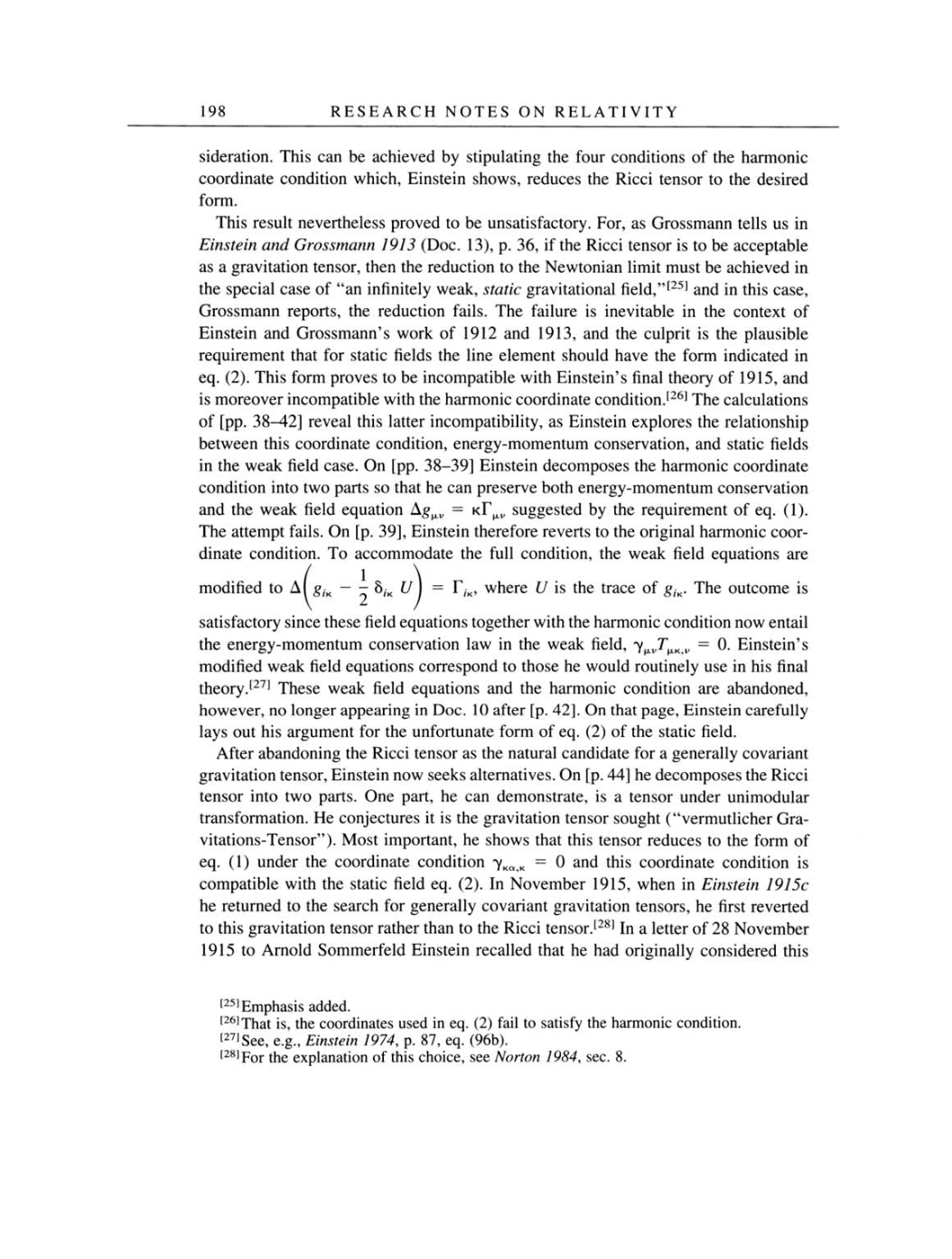198 RESEARCH
NOTES
ON RELATIVITY
sideration. This
can
be
achieved
by
stipulating
the
four conditions of
the
harmonic
coordinate condition
which,
Einstein
shows,
reduces
the
Ricci
tensor to
the desired
form.
This result nevertheless
proved
to be
unsatisfactory. For,
as
Grossmann tells
us
in
Einstein and Grossmann
1913
(Doc. 13),
p.
36,
if
the Ricci tensor is
to
be
acceptable
as a
gravitation
tensor,
then
the
reduction
to
the
Newtonian limit
must be
achieved
in
the
special
case
of "an
infinitely weak,
static
gravitational field,"[25]
and in this
case,
Grossmann
reports,
the
reduction
fails.
The failure
is
inevitable
in the context of
Einstein
and
Grossmann's work of
1912 and
1913,
and the
culprit
is the
plausible
requirement
that for
static fields the line
element should
have the
form
indicated
in
eq. (2).
This form
proves to
be
incompatible
with
Einstein's
final
theory
of
1915,
and
is
moreover
incompatible
with
the
harmonic coordinate
condition.[26] The
calculations
of
[pp.
38-42]
reveal
this
latter
incompatibility,
as
Einstein
explores
the
relationship
between this coordinate
condition,
energy-momentum
conservation,
and static
fields
in the
weak
field
case.
On
[pp.
38-39]
Einstein
decomposes
the
harmonic coordinate
condition
into two
parts
so
that
he
can
preserve
both
energy-momentum
conservation
and
the
weak
field
equation
Aguv
=
kTuv
suggested
by
the
requirement
of
eq.
(1).
The
attempt
fails. On
[p.
39],
Einstein therefore
reverts to the
original
harmonic
coor-
dinate condition.
To
accommodate
the full condition, the
weak
field
equations
are
modified
to
A(gik
-
1/28ik
U) =
Tik,
where
U is the trace
of
giK.
The
outcome is
satisfactory
since
these field
equations together
with
the
harmonic condition
now
entail
the
energy-momentum
conservation law in the weak
field,
yuvTuk,v
=
0.
Einstein's
modified weak
field
equations correspond
to
those
he
would
routinely use
in his final
theory.[27]
These weak
field
equations
and the
harmonic condition
are
abandoned,
however,
no
longer appearing
in Doc.
10
after
[p.
42].
On
that
page,
Einstein
carefully
lays
out his
argument
for
the
unfortunate form of
eq.
(2)
of
the
static
field.
After
abandoning
the
Ricci
tensor
as
the
natural candidate for
a
generally
covariant
gravitation
tensor,
Einstein
now
seeks alternatives.
On
[p. 44]
he
decomposes
the
Ricci
tensor into two
parts.
One
part,
he
can
demonstrate,
is
a
tensor
under unimodular
transformation.
He
conjectures
it
is
the
gravitation
tensor
sought
("vermutlicher Gra-
vitations-Tensor").
Most
important,
he
shows that
this tensor
reduces
to the
form of
eq.
(1)
under
the
coordinate condition
yKOl,K
=
0 and this
coordinate condition
is
compatible
with
the
static
field
eq.
(2).
In
November
1915,
when
in
Einstein
1915c
he
returned
to the
search for
generally
covariant
gravitation
tensors, he first
reverted
to this
gravitation
tensor
rather
than to the
Ricci
tensor.[28] In
a
letter of
28
November
1915 to
Arnold Sommerfeld Einstein recalled that
he had
originally
considered
this
[25]Emphasis
added.
[26]That
is,
the
coordinates used in
eq.
(2)
fail
to satisfy
the
harmonic condition.
[27]See,
e.g.,
Einstein
1974,
p.
87,
eq. (96b).
[28]For
the
explanation
of this
choice,
see
Norton
1984,
sec.
8.
